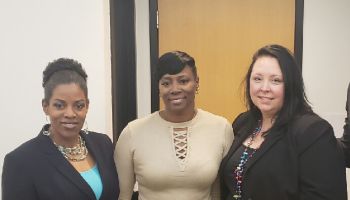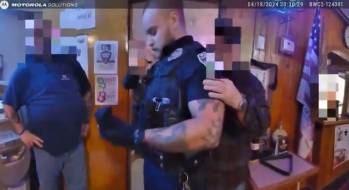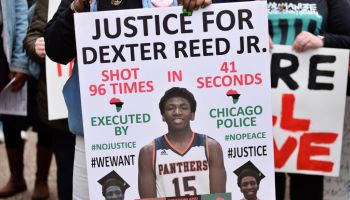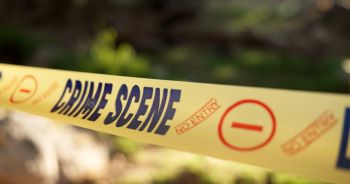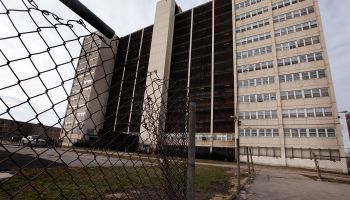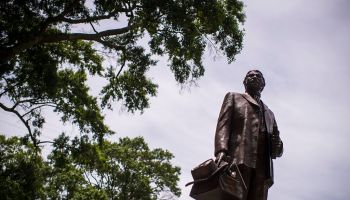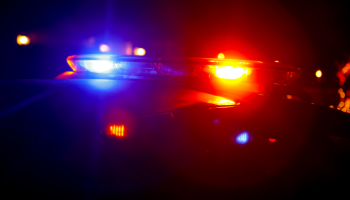
Source: JEWEL SAMAD/AFP/Getty Images
When 22-year-old Kalief Browder took his life, New York City heaved.
Browder spent three years on Rikers Island, the infamous jail where he suffered documented torture, including brutal attacks, constant confinement to a 6 foot by 8 foot cell and reported starvation. On June 7, the 22-year-old hung himself with an air conditioning cord in his mother’s house, gifting critics of Rikers a sweet-faced innocent whose tragic death demanded action.
Kalief, his name lyrical, now a mournful dirge, was sent to Rikers Island as a high school sophomore after being accused of taking a backpack in May 2010. New York is only one of only two states in the U.S. that automatically charges 16 and 17-year-olds as adults. After he was arrested, Browder was charged with robbery, grand larceny and assault, and because he was on probation for taking a delivery truck for a joy ride, shipped to the 400-acre facility between The Bronx and Queens.
Browder’s family could not afford his $3,000 bail, and so the 16-year-old spent more than three years at the sprawling jail complex without a trial, suffering relentless violence at both the hands of guards and inmates — some of the beatings captured on video.
Browder spent a combined two of three years in solitary confinement, which has been proven to trigger suicidal thoughts andpsychotic breaks. In fact, The New Yorker reports that in February 2012, Browder ripped his bed sheet into strips and tried to hang himself from the light fixture in his cell. His lawyer maintains that before he went to Rikers, the teen had no mental health problems.
“I think what caused the suicide was his incarceration and those hundreds and hundreds of nights in solitary confinement, where there were mice crawling up his sheets in that little cell,” Browder’s attorney Paul V. Prestia said in an interview with the LA Times.
“PEACE TO THE BROTHERS ON RIKERS ISLE…”
Rikers—made notorious by rap songs throughout the ’90s—had already made harrowing headlines in the months preceding Browder’s self-murder, getting press for everything from prisoner deaths and the guards being jailed for violence against inmates, to the indictment of jail union bosses and a damning federal investigation that demanded sweeping reforms. As a microcosm, Rikers stands as a symbol of all that is wrong with the criminal justice system in America—and how young people of color are destroyed by it.
Glenn Martin, the founder of Just Leadership USA, a Harlem-based organization that empowers formerly incarcerated men and women around policy reform, says that we are all responsible for places like Rikers, where young men like Kalief Browder slip through the cracks.
“Jail systems like this exist because people believe in them, because the citizens of New York have decided that this is how we are going to respond to crime,” says Martin. “When you think about stop-and-frisk in New York, we got to the point where there were 800,000 young people, particularly people of color, who were being stopped, and many of them ended up in that facility.”
A LONG, TROUBLED HISTORY
A May 2013 piece in Mother Jones magazine named Rikers Island one of the ten worst prisons in the United States, and that despite being the “the target of dozens of lawsuits and numerous exposes,” the jail is still a “dangerous place:”
.When it comes to ignominies, New York City’s island jail complex has it all: inmate violence, staff brutality, rape, abuse of adolescents and the mentally ill, and one of the nation’s highest rates of solitary confinement… [T]he East River island remains a dismal and dangerous place for the 12,000 or more men, women, and children held there on any given day—mostly pretrial defendants who can’t make bail and nonviolent offenders with sentences too short to ship them upstate
In 2014, the U.S. Department of Justice sued the city of New York over its treatment of young prisoners at Rikers, joining a class action lawsuit started in 2012. In a truly damning August 2014 report, federal prosecutor Preet Bharara eviscerated the jail, saying the city showed “deliberate indifference” to inmates’ constitutional rights and that there is “a deep-seated culture of violence” throughout the adolescent facilities at Rikers.
“I went to Rikers when I was 16, and that was the toughest time I probably ever had in my life,” says Martin. “I have like, three stab wounds that came from spending time in what they call the ‘gladiator school,’ which is where the youth are. And it’s not because these youth are particularly violent, it’s because it’s the only way they survive.”
Martin confirms that often guards are complicit in the abuse, creating a Lord of the Flies–like atmosphere, where correctional officers both know about—and perpetrate —violence against young inmates, which is consistent with the DOJ report and video of a teenage Browder being beaten by guards while handcuffed.
“Correctional officers choose who they think they want to ally themselves with, which young people they think are the strongest, and they give those young people a lot of leverage to run the dorm and run the cell block the way they want to run it,” says Martin.
And it is not only the adolescents who are the recipients of violence from the guards on Rikers. Adult women and especially the mentally ill, who by some reports make up 40 percent of the jail’s population, are especially vulnerable to violence.
In mid-June, a former Rikers Island captain was sentenced to five years in prison for allowing Jason Echeverria, a 25-year-old diagnosed with bipolar disorder, to die on the floor after ingesting a soap ball meant to clean his cell. The officer, Terrence Pendergrass, 51, literally ignored Echeverria’s pleas for help as he suffered in agony, and the sentencing judge in the case said that Pendergrass showed indifference and callousness to Echeverria’s life.
The week before, U.S. Attorney Bharara announced criminal charges against three other Rikers guards in connection with the 2012 fatal beating of inmate Ronald Spear. Victor Woods went into a violent seizure while a guard sat watching him and drinking a cup of coffee.
Then there is the story of Bradley Ballard, who according to an investigative report by New York Magazine and The Marshall Project:
“…was locked alone in his cell for six days without medication, insulin, food, or running water; officers and health workers remarked on the smell coming from his cell, but no one got up to help him until he went into cardiac arrest, covered in his own feces and with a rubber band around his genitals that had caused sepsis to set in.”
In fact, there are too many cases to name, each one more tragic than the next.
A BRAND NEW DAY?
In December, New York City Mayor Bill de Blasio toured Rikers for the first time during his tenure as mayor, and announced that solitary confinement would end for 16 and 17-year-olds there.
And on July 1, the mayor, Justice Department, and lawyers for injured inmates reached a settlement, which mandated specific reforms at Rikers, including banning guards from striking inmates in the head, using chokeholds, or kicking inmates unless they’re in imminent danger of death or serious injury.
The AP reports that the 63-page-consent decree sets specific deadlines for the creation of a computerized system to track use-of-force cases, and that such reforms will be overseen by a court-appointed monitor.
But even with the city’s settlement, and the mayor ending solitary confinement for those under 18, some activists say that it may be too little, too late, or even more of the same.
“They basically rebranded it and repackaged it,” says Khalil Cumberbatch, a 33-year-old policy associate at the Legal Action Center, which promotes penal reintegration in New York State. “It’s now called the ESHU [Enhanced Supervision Housing Unit, pronounced “shoe”]. The reality is solitary confinement for 16 and 17 year olds is not completely abolished. As a matter of fact, the mayor’s response was, ‘You know what, we won’t blatantly use solitary confinement for 16 and 17 year olds, what we’ll do is we’ll only save it for the most ‘violent’ offenders.” But violence means you could have been very well defending yourself and got into a really big fight in the housing unit four or five times. Yet you’re still considered ‘violent’ because you’re defending yourself. I’ve seen it happen multiple times at Rikers.”
SHUT IT DOWN!
Criminal justice reformers advocate both decriminalization (shutting down the pipeline), and reducing prison populations (draining the sea). Activists like Martin and Cumberbatch say they not only want to get youth like Kalief Browder off of Rikers Island, but shutter the entire jail for good. Most of that power rests with the mayor.
“Unfortunately, the mayor’s incremental reform doesn’t match the scope of the problem,” says Martin. “It’s like putting Band Aids on cancer. Our goal is literally close down the entire facility, to decentralize the jail, to shrink the number of beds, and to hold officers accountable. All of this can be done.”
“We have the ability, resources, and the political will to cut the population in half,” agrees Cumberbatch, who says at the very least, all adolescents should be removed from the lock up. “Right now there are 200-plus youth on Rikers Island. If the mayor sets a date that those youth need to be re-shifted and put into juvenile facilities, [those] designed to house and care for them, that would happen tomorrow. He has that ability for not only those 200-plus, but for a huge portion of the Rikers Island population.”
And with the constant death of martyrs like Browder, a surge of interest by both activists and concerned New Yorkers has converged to shutter Rikers permanently. Organizations like The Justice League are especially active in campaigns like New York’s #RaiseTheAge legislation.
“We don’t think the reforms are going to solve what’s going on in Rikers, we think it needs to just be shut down,” says Denise Romero, an advocate who took part in a June 27 rally outside of the prison.
But Martin before we can do that, Martin thinks we may have to reconsider our views on crime—and how we mete out punishment.
“Kalief’s death is just yet another example of how we have decided to respond to poverty, mental illness, and lack of health care with law enforcement,” says Martin. “Although there is this national dialogue now about criminal justice reform and policing, in the end these are real human lives that are being impacted.
“I don’t see how any New Yorker can sit back and see almost 10,000 people facing this sort of wicked treatment and be comfortable going to sleep at night.”
SEE ALSO:
Bail Equals Inequality: The Kalief Browder Case & Why Freedom Costs Money
Feds To Oversee Reforms At Rikers Island After Widespread Abuse Against Teens
Man Arrested As Teen Has Spent 7 Years On Rikers Awaiting Trial
Angela Bronner Helm is a journalism professor at The City College of New York and an editorial consultant. Follow her on Twitter.











